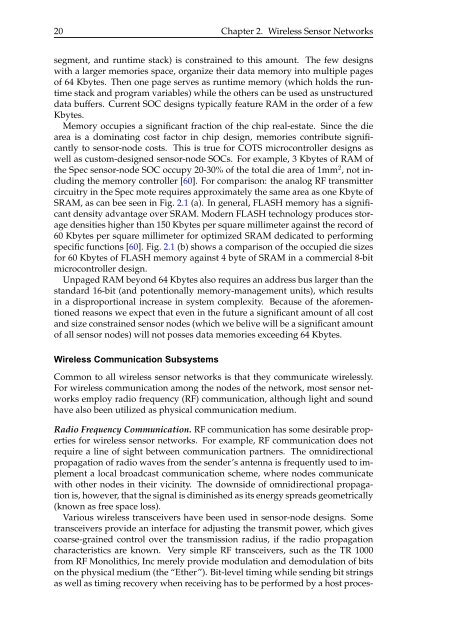A State-Based Programming Model for Wireless Sensor Networks
A State-Based Programming Model for Wireless Sensor Networks
A State-Based Programming Model for Wireless Sensor Networks
You also want an ePaper? Increase the reach of your titles
YUMPU automatically turns print PDFs into web optimized ePapers that Google loves.
20 Chapter 2. <strong>Wireless</strong> <strong>Sensor</strong> <strong>Networks</strong><br />
segment, and runtime stack) is constrained to this amount. The few designs<br />
with a larger memories space, organize their data memory into multiple pages<br />
of 64 Kbytes. Then one page serves as runtime memory (which holds the runtime<br />
stack and program variables) while the others can be used as unstructured<br />
data buffers. Current SOC designs typically feature RAM in the order of a few<br />
Kbytes.<br />
Memory occupies a significant fraction of the chip real-estate. Since the die<br />
area is a dominating cost factor in chip design, memories contribute significantly<br />
to sensor-node costs. This is true <strong>for</strong> COTS microcontroller designs as<br />
well as custom-designed sensor-node SOCs. For example, 3 Kbytes of RAM of<br />
the Spec sensor-node SOC occupy 20-30% of the total die area of 1mm 2 , not including<br />
the memory controller [60]. For comparison: the analog RF transmitter<br />
circuitry in the Spec mote requires approximately the same area as one Kbyte of<br />
SRAM, as can bee seen in Fig. 2.1 (a). In general, FLASH memory has a significant<br />
density advantage over SRAM. Modern FLASH technology produces storage<br />
densities higher than 150 Kbytes per square millimeter against the record of<br />
60 Kbytes per square millimeter <strong>for</strong> optimized SRAM dedicated to per<strong>for</strong>ming<br />
specific functions [60]. Fig. 2.1 (b) shows a comparison of the occupied die sizes<br />
<strong>for</strong> 60 Kbytes of FLASH memory against 4 byte of SRAM in a commercial 8-bit<br />
microcontroller design.<br />
Unpaged RAM beyond 64 Kbytes also requires an address bus larger than the<br />
standard 16-bit (and potentionally memory-management units), which results<br />
in a disproportional increase in system complexity. Because of the a<strong>for</strong>ementioned<br />
reasons we expect that even in the future a significant amount of all cost<br />
and size constrained sensor nodes (which we belive will be a significant amount<br />
of all sensor nodes) will not posses data memories exceeding 64 Kbytes.<br />
<strong>Wireless</strong> Communication Subsystems<br />
Common to all wireless sensor networks is that they communicate wirelessly.<br />
For wireless communication among the nodes of the network, most sensor networks<br />
employ radio frequency (RF) communication, although light and sound<br />
have also been utilized as physical communication medium.<br />
Radio Frequency Communication. RF communication has some desirable properties<br />
<strong>for</strong> wireless sensor networks. For example, RF communication does not<br />
require a line of sight between communication partners. The omnidirectional<br />
propagation of radio waves from the sender’s antenna is frequently used to implement<br />
a local broadcast communication scheme, where nodes communicate<br />
with other nodes in their vicinity. The downside of omnidirectional propagation<br />
is, however, that the signal is diminished as its energy spreads geometrically<br />
(known as free space loss).<br />
Various wireless transceivers have been used in sensor-node designs. Some<br />
transceivers provide an interface <strong>for</strong> adjusting the transmit power, which gives<br />
coarse-grained control over the transmission radius, if the radio propagation<br />
characteristics are known. Very simple RF transceivers, such as the TR 1000<br />
from RF Monolithics, Inc merely provide modulation and demodulation of bits<br />
on the physical medium (the “Ether”). Bit-level timing while sending bit strings<br />
as well as timing recovery when receiving has to be per<strong>for</strong>med by a host proces-
















